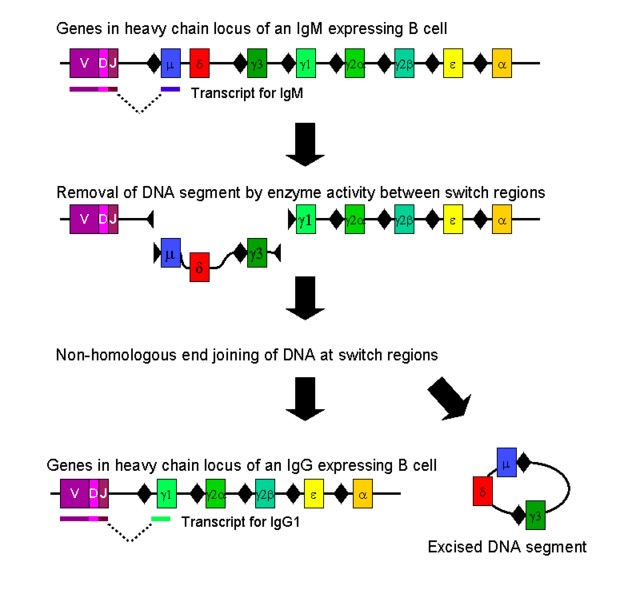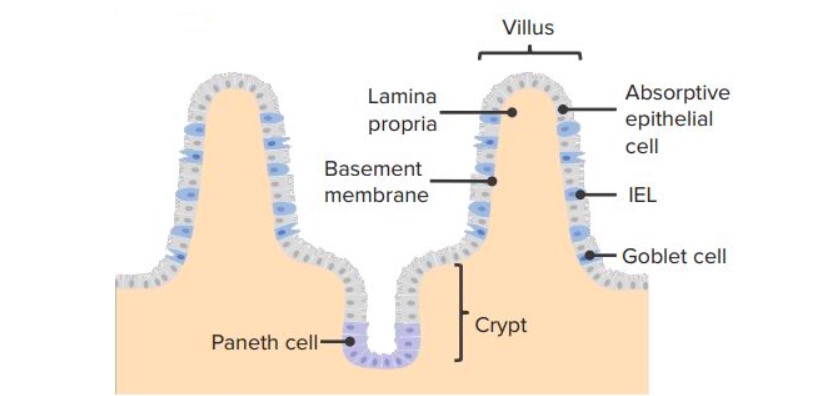Playlist
Show Playlist
Hide Playlist
Main Pathways and Endogenous/Exogenous Antigens – Antigen Processing and Presentation
-
Slides Processing & Presentation of Antigen.pdf
-
Reference List Immune System.pdf
-
Download Lecture Overview
00:01 So how are these peptides actually generated? Well they’re generated by antigen processing. 00:08 And that antigen can come from two locations. 00:12 The action can be within a cell, in that case we refer to it as endogenous antigen. 00:19 And processing of antigens that are within the cell; endogenous antigens produces peptides that are eight to nine amino acids long. 00:30 And this is a necessary length for presentation by MHC Class I because the peptide binding groove in MHC Class I specifically binds peptides of this length. 00:42 In contrast, antigen that is present outside of cells, exogenous antigen that is then taken up for example by a phagocytic cell. 00:54 These are processed into peptides that are rather longer, approximately 15 amino acids, can be 20 or so. 01:03 But typically around about 15 amino acids, sometimes a little bit shorter but you know on average around about 15 amino acids long for presentation by MHC Class II. 01:13 Let’s look now at the actual enzymes and structures that are involved in this processing of protein antigen. 01:24 So here we have an example of an endogenous antigen. 01:27 It could be a protein from a virus that’s infecting a cell for example. 01:33 The first thing that happens is that this protein becomes ubiquitinated. 01:40 It has a tag, an ubiquitine tag added to it. 01:45 This causes it to be fed into a structure that is called the proteasome. 01:51 Now all cells have proteasomes in them and they are complexes of enzymes that form a tube-like structure and proteins are fed in at one end and come out the other end being chopped up. 02:05 And it’s a way in which cells get rid of sort of worn out proteins. 02:10 But when cells become infected with viruses or other pathogens, they actually modify the constitutive proteasome. 02:19 They add some units to it that then mean it’s a immunoproteasome. 02:26 And the difference between the constitutive protein and the immunoproteasome is that the immunoproteasome is specialized to produce peptides of the length that’s required to bind into the MHC Class I groove; in other words, peptides of around about eight or nine amino acids long. 02:44 So we have have an infected cell here because it’s got an immunoproteasome. 02:47 That tells us it must be infected because we only see immunoproteasomes in infected cells. 02:53 The protein is then fed into the immunoproteasome. 02:57 Meanwhile, in the endoplasmic reticulum, all of our nucleated cells are all the time producing many, many, many different proteins and one of those proteins will be MHC Class I. 03:09 And there are other proteins that are produced in the endoplasmic reticulum that associate with MHC Class I. 03:16 And three of the important ones are tapasin, calreticulin and a protein called Erp57. 03:25 And they help keep the conformation of the MHC Class I correct for peptide binding. 03:33 So the protein’s being fed into the immunoproteasome. 03:37 And then at the other end, we get these peptides that are eight or nine amino acids long. 03:41 Now that’s good, we need peptides that are eight or nine amino acids long. 03:45 And we’ve got the MHC, so that’s good. 03:47 But there’s a kind of problem here isn’t there, because the peptides are in the cytosol. 03:52 But the MHC Class I is in the endoplasmic reticulum. 03:56 So we have to get those together. 03:57 And the way that that happens is that these peptides, as they’re being fed out of the end of the immunoproteasome, they are picked up by two molecules that span the membrane of the endoplasmic reticulum. 04:12 And these two molecules are called TAP1 and TAP2 - the Transporters associated with Antigen Processing 1 and 2. 04:22 And these TAP1 and TAP2 molecules pick up the peptides on the cytoplasmic face of the membrane of the endoplasmic reticulum and take them across into the endoplasmic reticulum. 04:37 So you can see the peptide’s being taken up and now getting into the endoplasmic reticulum. 04:42 And they can be put into the peptide binding groove of MHC Class I. 04:49 This complex of peptide plus MHC then buds off from the endoplasmic reticulum and vesicles are transported through the cell, ultimately to the cell surface where the peptide MHC can be recognized by the T-cell receptor. 05:06 And in this case, you will need a CD8+ T-cell to recognize the MHC Class I molecule. 05:14 So the T-cell receptor recognizes peptide MHC, the CD8 recognizes the non-polymorphic region of Class I. 05:25 Let’s have a look at processing of exogenous antigen, antigen coming from outside the cell. 05:30 So for example a phagocytic cell phagocytosing an antigen or a cell endocytosing an antigen. 05:37 The protein antigen is taken up by endocytosis or phagocytosis. 05:42 And meanwhile in professional antigen presenting cells, as well as making MHC Class I in the endoplasmic reticulum, they’re making MHC Class II. 05:52 The MHC Class II associates with a molecule that’s called invariant chain (Ii) - big I little i. 06:01 This acts as a kind of cork in a bottle type of situation. 06:06 It acts as a stopper, because you’ll recall from the previous slides that you’re feeding peptide into the endoplasmic reticulum, peptides that have come from the immunoproteasome. 06:17 You don’t want those peptides to bind into the MHC Class II groove, you want them to bind into the MHC Class I groove. 06:24 So to prevent peptide binding in the endoplasmic reticulum, the peptides that are destined to meet up with MHC Class II, there’s this stopper in the peptide binding groove for Class II called invariant chain. 06:39 Meanwhile following endocytosis or phagocytosis, there are various enzymes that are produced within the endosomes and the phagosomes that will degrade the protein to peptides that are approximately 15 amino acids long, in other words the right length to be presented by MHC Class II. 07:00 The vesicles bud off from the endoplasmic reticulum with the MHC Class II and the invariant chain, and eventually these are going to meet up. 07:10 And they fuse within the cytoplasms of the vesicle containing the peptides, fuses with the vesicle containing the MHC Class II plus the invariant chain. 07:21 At this point in time, the invariant chain gets partly degraded and most of it is chewed away by enzymes, leaving just a little bit of the invariant chain left. 07:31 And that little bit of the invariant chain is called CLIP. 07:36 Subsequently two molecules called DM and DO remove CLIP and insert the peptide into the peptide binding groove. 07:47 And then the exchange occurs between CLIP and the peptides. 07:54 And the peptide MHC complex then moves to the cell surface where it can be recognized by CD4+ T-cells. 08:04 The T-cell receptor recognizing the combination of peptide plus MHC Class II, and the CD4 recognizing the non-polymorphic regions of the MHC Class II molecule.
About the Lecture
The lecture Main Pathways and Endogenous/Exogenous Antigens – Antigen Processing and Presentation by Peter Delves, PhD is from the course Adaptive Immune System. It contains the following chapters:
- The Main Pathways of Antigen Processing
- Endogenous Antigen Processing and Presentation
- Exogenous Antigen Processing and Presentation
Included Quiz Questions
What is the molecule that prevents the binding of endogenous peptides to the binding groove on the major histocompatibility complex (MHC) class II within the endoplasmic reticulum?
- Invariant chain (Ii)
- Transporter associated with antigen processing 1
- Erp57
- Transporter associated with antigen processing 2
- Tapasin
Which of the following approximate peptide lengths are most appropriate for binding major histocompatibility complex (MHC) class I and II, respectively?
- 8-9 amino acids and 15 amino acids
- 15 amino acids and 8-9 amino acids
- 80-90 amino acids and 150 amino acids
- 150 amino acids and 80-90 amino acids
- The appropriate number of amino acids does not vary between the two MHC classes.
Which of the following best describes ubiquitination?
- Marking of a protein for degradation by the proteasome
- Activating a functional protein
- Marking of a protein for recognition by surface receptors of a cell
- Generating peptides that ultimately form a structural protein
- Presentation of a peptide by the The major histocompatibility complex class II
Immunoproteasomes cleave protein substrates to produce high‐quality peptides. This is mainly done for which of the following purposes? (MHC: major histocompatibility complex)
- For MHC‐class I presentation and cytotoxic T cell activation
- For MHC‐class II presentation and cytotoxic T cell activation
- For MHC‐class I presentation and helper T cell activation
- For MHC‐class II presentation and helper T cell activation
- For MHC‐class II presentation and regular T cell activation
Which of the following best characterizes the role of transporter associated with antigen processing 1 and 2?
- Translocation of short peptides from the cytosol into the lumen of the endoplasmic reticulum for presentation to MHC class I
- Translocation of short peptides from the lumen of the endoplasmic reticulum into the cytosol for presentation to MHC class I
- Translocation of short peptides from the cytosol into the lumen of the endoplasmic reticulum for presentation to MHC class II
- Translocation of short peptides from the lumen of the endoplasmic reticulum into the cytosol for presentation to MHC class II
- Translocation of long peptides from the lumen of the endoplasmic reticulum into the cytosol for presentation to MHC class I
Customer reviews
5,0 of 5 stars
| 5 Stars |
|
5 |
| 4 Stars |
|
0 |
| 3 Stars |
|
0 |
| 2 Stars |
|
0 |
| 1 Star |
|
0 |





